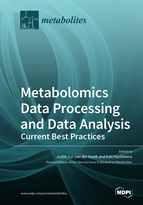Metabolomics Data Processing and Data Analysis—Current Best Practices
A special issue of Metabolites (ISSN 2218-1989). This special issue belongs to the section "Bioinformatics and Data Analysis".
Deadline for manuscript submissions: closed (31 May 2019) | Viewed by 138662
Special Issue Editors
Interests: food and nutritional metabolomics; LC-MS based metabolic profiling approaches; development of data-analytical procedures for metabolomics
Special Issues, Collections and Topics in MDPI journals
Interests: metabolomics; metabolite annotation; metabolite identification; metabolome mining; mass spectrometry; mass fragmentation; machine learning-based approaches; substructures; chemical classes; natural product discovery; food metabolome
Special Issues, Collections and Topics in MDPI journals
Special Issue Information
Dear Colleagues,
Metabolomics data-analytical approaches are developing with accelerating speed, alongside technical improvements in the instrumentation used in the field. There is currently a plethora of vendor-specific and open source software solutions for various aspects of the metabolomics data-analysis—some of which are covering the whole workflow, whereas some are focusing on specific aspects, such as the in silico prediction of metabolite structures. Thus, the choice of methods for new scholars entering the field may be confusing, and the selection of suitable approach is a tedious process. This Special Issue is devoted to reviewing the current practical aspects of metabolomic data-analytical workflows, starting from the data collection all the way to the presentation of publication-ready metabolomics results, to serve as a tutorial on the current best practices. We therefore invite review and viewpoint manuscripts devoted to various aspect within non-targeted metabolite profiling data-analysis with a specific emphasis on peak picking, data preprocessing (e.g., normalization, scaling, imputation), metabolite annotation and identification, as well as visualization practices. Finally, we also invite manuscripts with innovative and integrative solutions towards peak picking and metabolite annotations—which may well become “current practices” in the near future.
The Special Issue is open for submission now. A proper extension may be granted. Please kindly let us know in advance. Accepted papers will be published continuously in the journal (as soon as accepted) and will be listed together on the special issue website.
Dr. Kati Hanhineva
Dr. Justin van der Hooft
Guest Editors
Manuscript Submission Information
Manuscripts should be submitted online at www.mdpi.com by registering and logging in to this website. Once you are registered, click here to go to the submission form. Manuscripts can be submitted until the deadline. All submissions that pass pre-check are peer-reviewed. Accepted papers will be published continuously in the journal (as soon as accepted) and will be listed together on the special issue website. Research articles, review articles as well as short communications are invited. For planned papers, a title and short abstract (about 100 words) can be sent to the Editorial Office for announcement on this website.
Submitted manuscripts should not have been published previously, nor be under consideration for publication elsewhere (except conference proceedings papers). All manuscripts are thoroughly refereed through a single-blind peer-review process. A guide for authors and other relevant information for submission of manuscripts is available on the Instructions for Authors page. Metabolites is an international peer-reviewed open access monthly journal published by MDPI.
Please visit the Instructions for Authors page before submitting a manuscript. The Article Processing Charge (APC) for publication in this open access journal is 2700 CHF (Swiss Francs). Submitted papers should be well formatted and use good English. Authors may use MDPI's English editing service prior to publication or during author revisions.
Keywords
- metabolomics
- data processing
- data analysis
- data interpretation: annotation and visualization








